Pecharsky V.K., Zavalij P.Y. Fundamentals of Powder Diffraction and Structural Characterization of Materials
Подождите немного. Документ загружается.

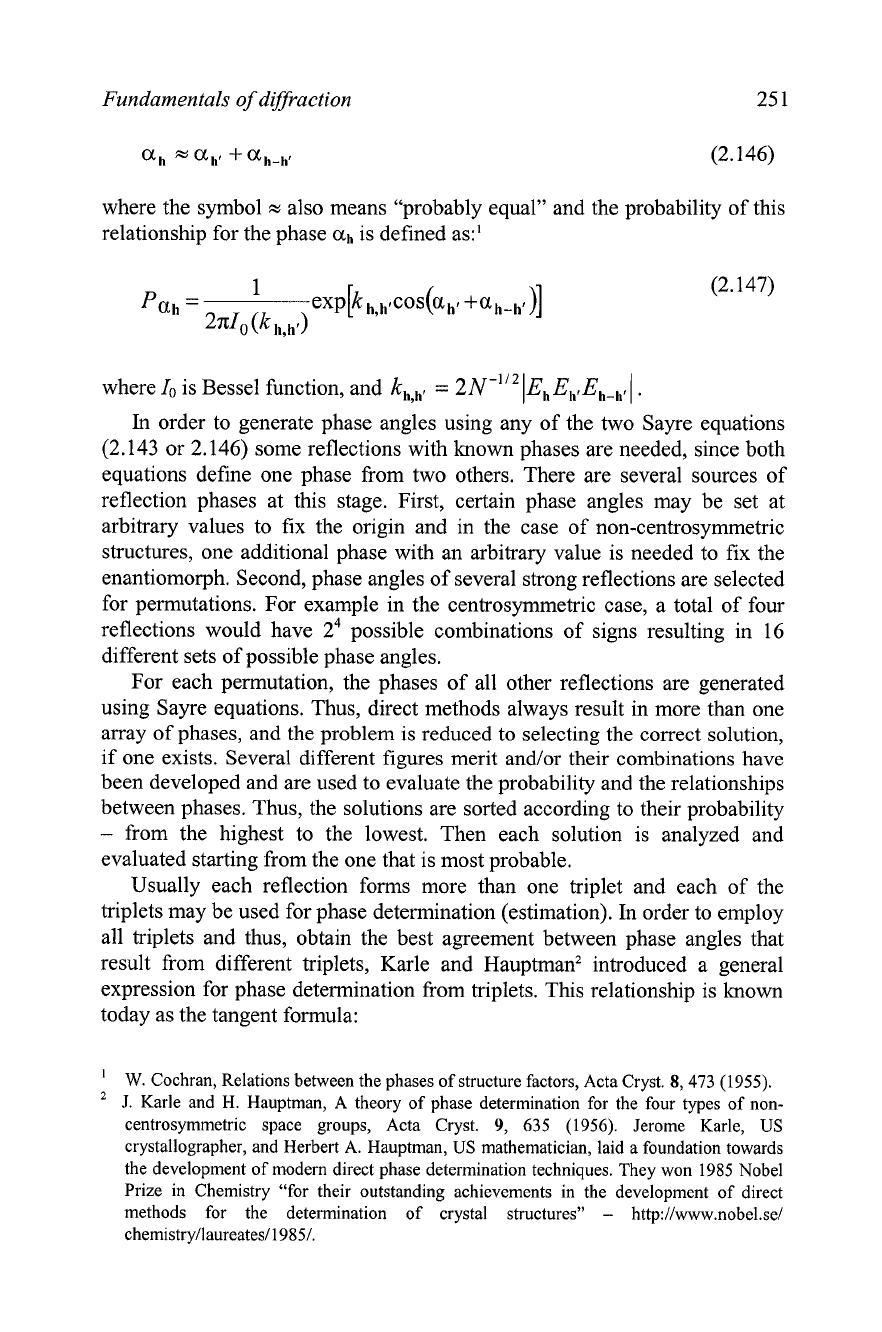
Fundamentals of diffraction
25 1
where the symbol
=
also means "probably equal" and the probability of this
relationship for the phase
ah
is defined as:'
where
b
is Bessel function, and
k,,,.
=
2~-''~
IE,
E,. E,-,,.
I
.
In
order to generate phase angles using any of the two Sayre equations
(2.143 or 2.146) some reflections with known phases are needed, since both
equations define one phase from two others. There are several sources of
reflection phases at this stage. First, certain phase angles may be set at
arbitrary values to fix the origin and in the case of non-centrosymmetric
structures, one additional phase with an arbitrary value is needed to fix the
enantiomorph. Second, phase angles of several strong reflections are selected
for permutations. For example in the centrosyrnmetric case, a total of four
reflections would have
24 possible combinations of signs resulting in 16
different sets of possible phase angles.
For each permutation, the phases of all other reflections are generated
using
Sayre equations. Thus, direct methods always result in more than one
array of phases, and the problem is reduced to selecting the correct solution,
if one exists. Several different figures merit andlor their combinations have
been developed and are used to evaluate the probability and the relationships
between phases. Thus, the solutions are sorted according to their probability
-
from the highest to the lowest. Then each solution is analyzed and
evaluated starting from the one that is most probable.
Usually each reflection forms more than one triplet and each of the
triplets may be used for phase determination (estimation).
In
order to employ
all triplets and thus, obtain the best agreement between phase angles that
result from different triplets, Karle and
Hauptrnan2 introduced a general
expression for phase determination from triplets. This relationship is known
today as the tangent formula:
'
W.
Cochran, Relations between the phases of structure factors, Acta Cryst.
8,473
(1955).
J. Karle and H. Hauptman,
A
theory of phase determination for the four types of non-
centrosymmetric space groups, Acta Cryst.
9,
635 (1956). Jerome Karle, US
crystallographer, and Herbert
A.
Hauptman, US mathematician, laid a foundation towards
the development of modern direct phase determination techniques. They won 1985 Nobel
Prize in Chemistry "for their outstanding achievements in the development of direct
methods for the determination of crystal structures"
-
http://m.nobel.se/
chemistry/laureates/1985/.
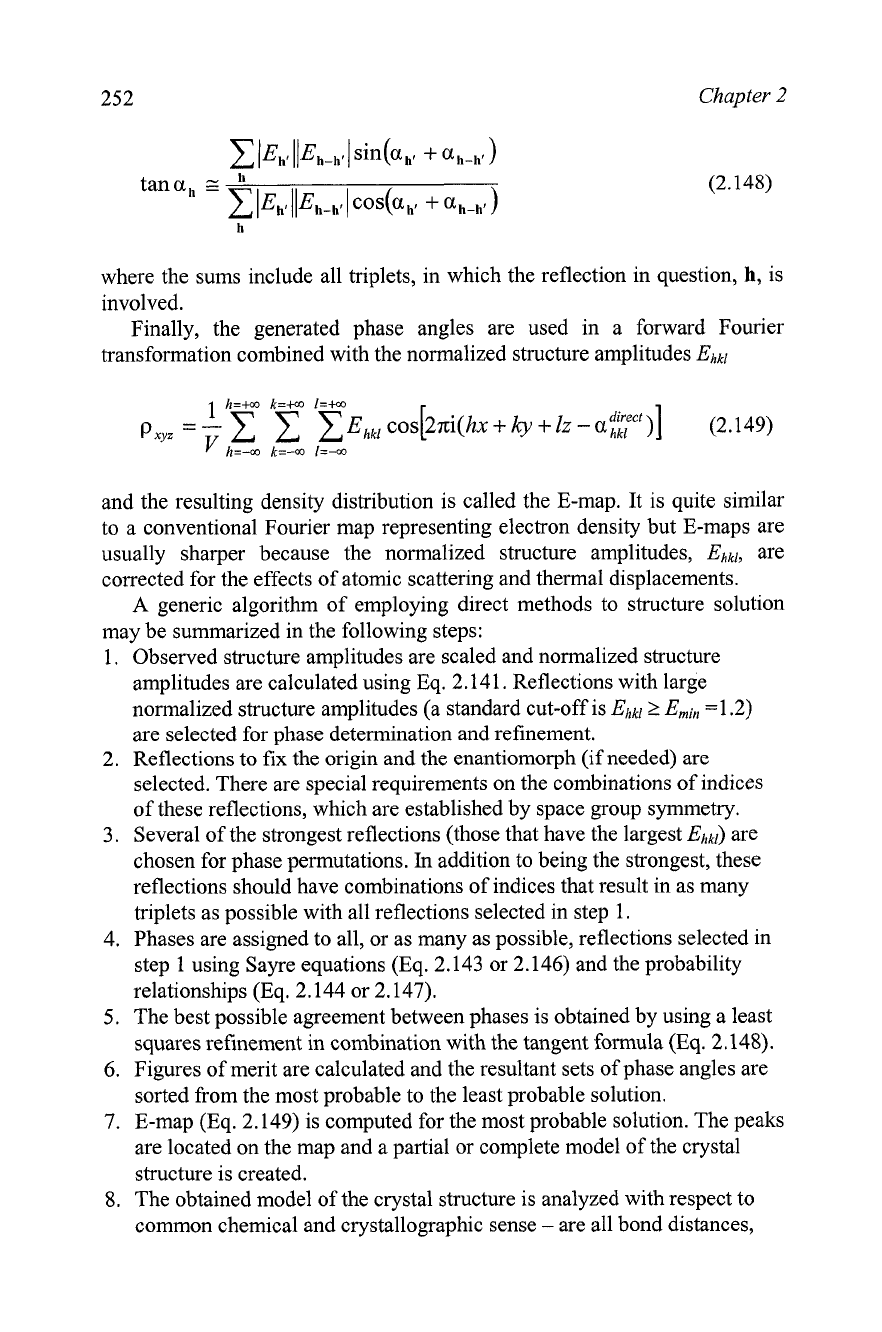
252
Chapter
2
where the sums include all triplets, in which the reflection in question,
h,
is
involved.
Finally, the generated phase angles are used in a forward Fourier
transformation combined with the normalized structure amplitudes
Ejkl
and the resulting density distribution is called the E-map. It is quite similar
to a conventional Fourier map representing electron density but E-maps are
usually sharper because the normalized structure amplitudes,
Ejkl,
are
corrected for the effects of atomic scattering and thermal displacements.
A
generic algorithm of employing direct methods to structure solution
may be summarized in the following steps:
1.
Observed structure amplitudes are scaled and normalized structure
amplitudes are calculated using Eq.
2.141.
Reflections with large
normalized structure amplitudes (a standard cut-off is
Ejkl
2
Emin =1.2)
are selected for phase determination and refinement.
2.
Reflections to fix the origin and the enantiomorph (if needed) are
selected. There are special requirements on the combinations of indices
of these reflections, which are established by space group symmetry.
3.
Several of the strongest reflections (those that have the largest
Ejkl)
are
chosen for phase permutations.
In
addition to being the strongest, these
reflections should have combinations of indices that result in as many
triplets as possible with all reflections selected in step
1.
4.
Phases are assigned to all, or as many as possible, reflections selected in
step
1
using Sayre equations (Eq.
2.143
or
2.146)
and the probability
relationships (Eq.
2.144
or
2.147).
5.
The best possible agreement between phases is obtained by using a least
squares refinement in combination with the tangent formula (Eq.
2.148).
6.
Figures of merit are calculated and the resultant sets of phase angles are
sorted fiom the most probable to the least probable solution.
7.
E-map (Eq.
2.149)
is computed for the most probable solution. The peaks
are located on the map and a partial or complete model of the crystal
structure is created.
8,
The obtained model of the crystal structure is analyzed with respect to
common chemical and crystallographic sense
-
are all bond distances,
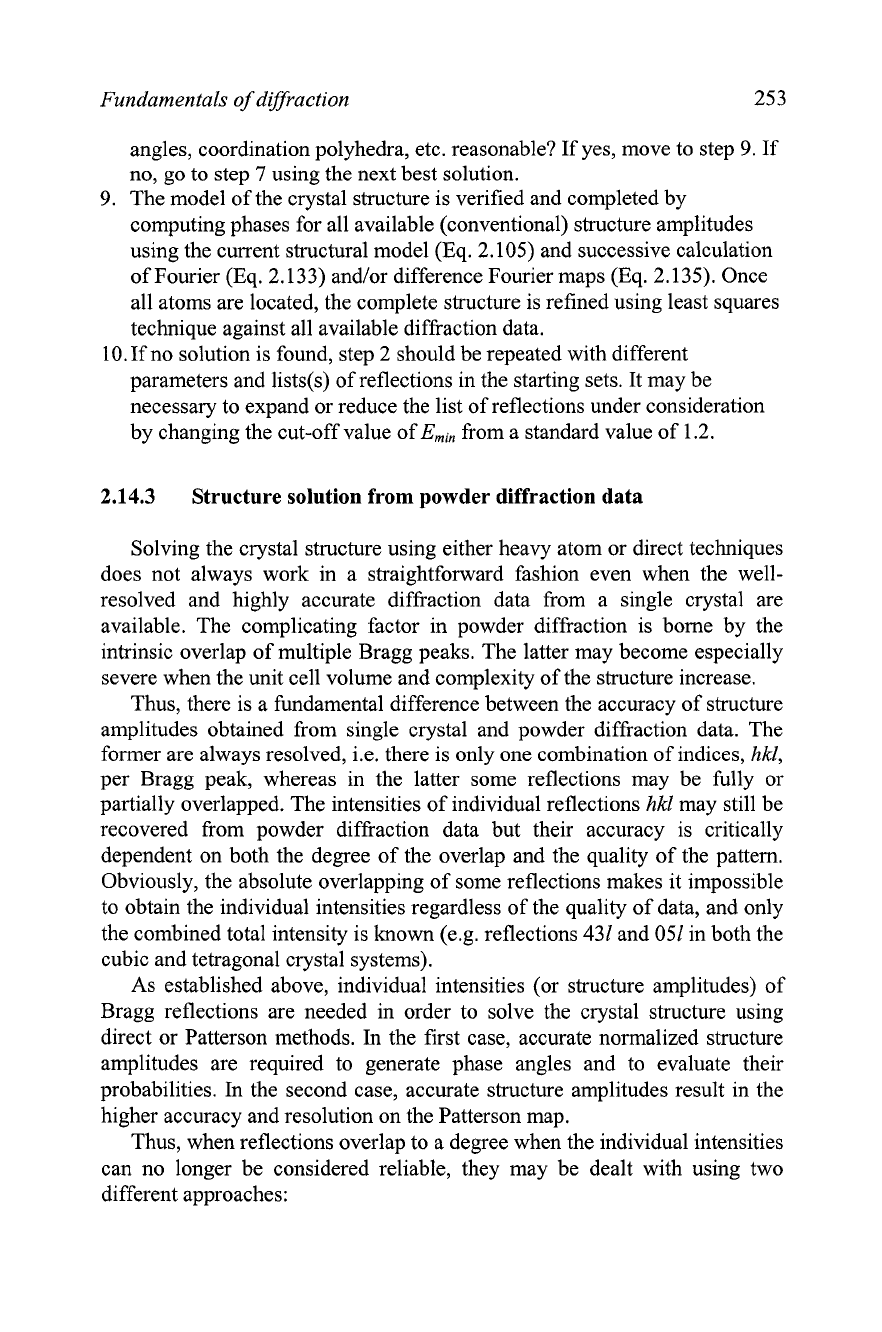
Fundamentals
of
diffraction
angles, coordination polyhedra, etc. reasonable? If yes, move to step
9.
If
no, go to step
7
using the next best solution.
9.
The model of the crystal structure is verified and completed by
computing phases for all available (conventional) structure amplitudes
using the current structural model (Eq. 2.105) and successive calculation
of Fourier (Eq. 2.133)
and/or difference Fourier maps (Eq. 2.135). Once
all atoms are located, the complete structure is refined using least squares
technique against all available diffraction data.
10. If no solution is found, step 2 should be repeated with different
parameters and
lists(s) of reflections in the starting sets. It may be
necessary to expand or reduce the list of reflections under consideration
by changing the cut-off value of
Emin
from a standard value of 1.2.
2.14.3
Structure solution from powder diffraction data
Solving the crystal structure using either heavy atom or direct techniques
does not always work in a straightforward fashion even when the well-
resolved and highly accurate diffraction data from a single crystal are
available. The complicating factor in powder diffraction is borne by the
intrinsic overlap of multiple Bragg peaks. The latter may become especially
severe when the unit cell volume and complexity of the structure increase.
Thus, there is a fundamental difference between the accuracy of structure
amplitudes obtained from single crystal and powder diffraction data. The
former are always resolved,
i.e. there is only one combination of indices,
hkl,
per Bragg peak, whereas in the latter some reflections may be fully or
partially overlapped. The intensities of individual reflections
hkl
may still be
recovered from powder diffraction data but their accuracy is critically
dependent on both the degree of the overlap and the quality of the pattern.
Obviously, the absolute overlapping of some reflections makes it impossible
to obtain the individual intensities regardless of the quality of data, and only
the combined total intensity is known
(e.g. reflections 431 and 051 in both the
cubic and tetragonal crystal systems).
As established above, individual intensities (or structure amplitudes) of
Bragg reflections are needed in order to solve the crystal structure using
direct or Patterson methods.
In
the first case, accurate normalized structure
amplitudes are required to generate phase angles and to evaluate their
probabilities. In the second case, accurate structure amplitudes result in the
higher accuracy and resolution on the Patterson map.
Thus, when reflections overlap to a degree when the individual intensities
can no longer be considered reliable, they may be dealt with using two
different approaches:
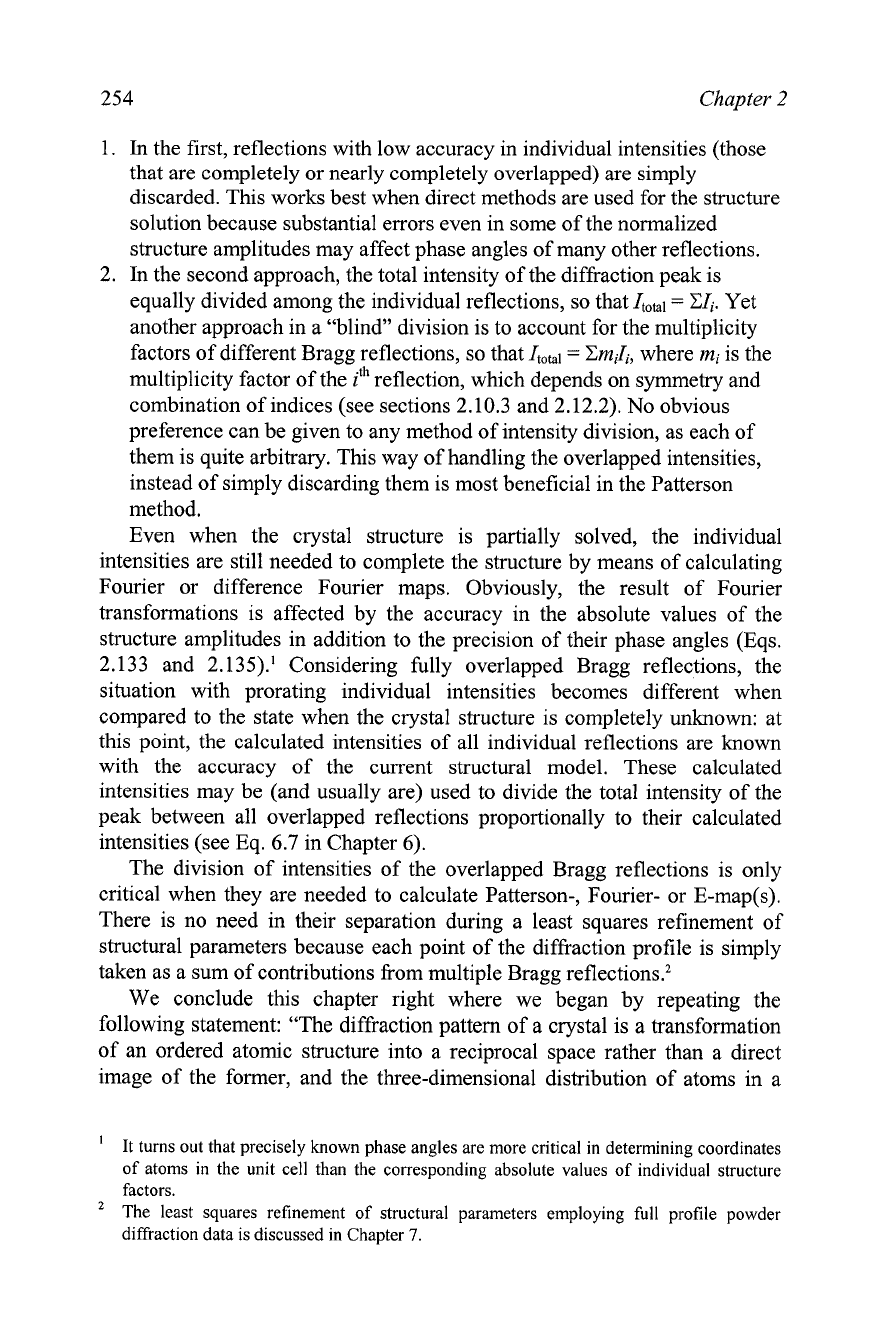
254
Chapter
2
1.
In
the first, reflections with low accuracy in individual intensities (those
that are completely or nearly completely overlapped) are simply
discarded. This works best when direct methods are used for the structure
solution because substantial errors even in some of the normalized
structure amplitudes may affect phase angles of many other reflections.
2.
In
the second approach, the total intensity of the diffraction peak is
equally divided among the individual reflections, so that
It,,1
=
XIi.
Yet
another approach in a "blind" division is to account for the multiplicity
factors of different Bragg reflections, so that
Ito,l
=
XmiIi,
where
mi
is the
multiplicity factor of the
ith
reflection, which depends on symmetry and
combination of indices (see sections 2.10.3 and 2.12.2). No obvious
preference can be given to any method of intensity division, as each of
them is quite arbitrary. This way of handling the overlapped intensities,
instead of simply discarding them is most beneficial in the Patterson
method.
Even when the crystal structure is partially solved, the individual
intensities are still needed to complete the structure by means of calculating
Fourier or difference Fourier maps. Obviously, the result of Fourier
transformations is affected by the accuracy in the absolute values of the
structure amplitudes in addition to the precision of their phase angles (Eqs.
2.133 and
2.135)' Considering fully overlapped Bragg reflections, the
situation with prorating individual intensities becomes different when
compared to the state when the crystal structure is completely unknown: at
this point, the calculated intensities of all individual reflections are known
with the accuracy of the current structural model. These calculated
intensities may be (and usually are) used to divide the total intensity of the
peak between all overlapped reflections proportionally to their calculated
intensities (see Eq.
6.7
in Chapter
6).
The division of intensities of the overlapped Bragg reflections is only
critical when they are needed to calculate Patterson-, Fourier- or E-map(s).
There is no need in their separation during a least squares refinement of
structural parameters because each point of the diffraction profile is simply
taken as a sum of contributions from multiple Bragg
reflection^.^
We conclude this chapter right where we began by repeating the
following statement: "The diffraction pattern of a crystal is a transformation
of an ordered atomic structure into a reciprocal space rather than a direct
image of the former, and the three-dimensional distribution of atoms in a
It turns out that precisely known phase angles are more critical in determining coordinates
of atoms in the unit cell than the corresponding absolute values of individual structure
factors.
The least squares refinement of structural parameters employing full profile powder
diffraction data is discussed in Chapter
7.
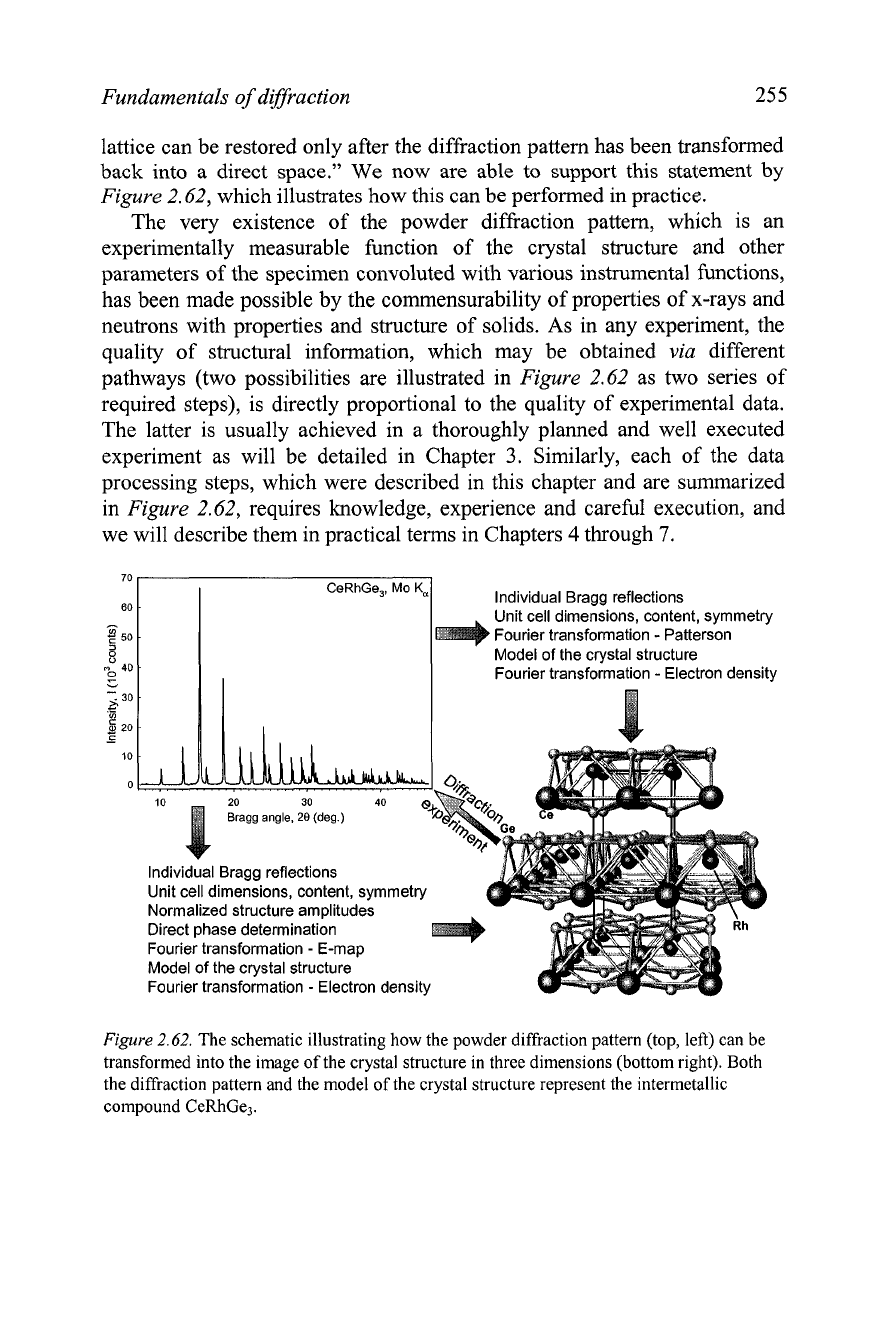
Fundamentals of diffraction
255
lattice can be restored only after the diffraction pattern has been transformed
back into a direct space." We now are able to support this statement by
Figure
2.62, which illustrates how this can be performed in practice.
The very existence of the powder diffraction pattern, which is an
experimentally measurable function of the crystal structure and other
parameters of the specimen convoluted with various instrumental functions,
has been made possible by the commensurability of properties of x-rays and
neutrons with properties and structure of solids. As in any experiment, the
quality of structural information, which may be obtained
via
different
pathways (two possibilities are illustrated
in
Figure
2.62 as two series of
required steps), is directly proportional to the quality of experimental data.
The latter is usually achieved in a thoroughly planned and well executed
experiment as will be detailed in Chapter
3.
Similarly, each of the data
processing steps, which were described in this chapter and are summarized
in
Figure
2.62, requires knowledge, experience and careful execution, and
we will describe them in practical terms in Chapters 4 through
7.
CeRhGe,,
Mo
K,
Individual Bragg reflections
Unit cell dimensions, content, symmetry
Fourier transformation
-
Patterson
8
Model of the crystal structure
n
40
Fourier transformation
-
Electron density
10
20
30
40
Bragg angle,
28
(deg.)
Individual Bragg reflections
Unit cell dimensions, content, symmetry
Normalized structure amplitudes
C
Direct phase determination
Fourier transformation
-
E-map
Model of the crystal structure
Fourier transformation
-
Electron density
Figure
2.62.
The schematic illustrating how the powder diffraction pattern (top, left) can be
transformed into the image of the crystal structure in three dimensions (bottom right). Both
the diffraction pattern and the model of the crystal structure represent the intermetallic
compound CeRhGe,.
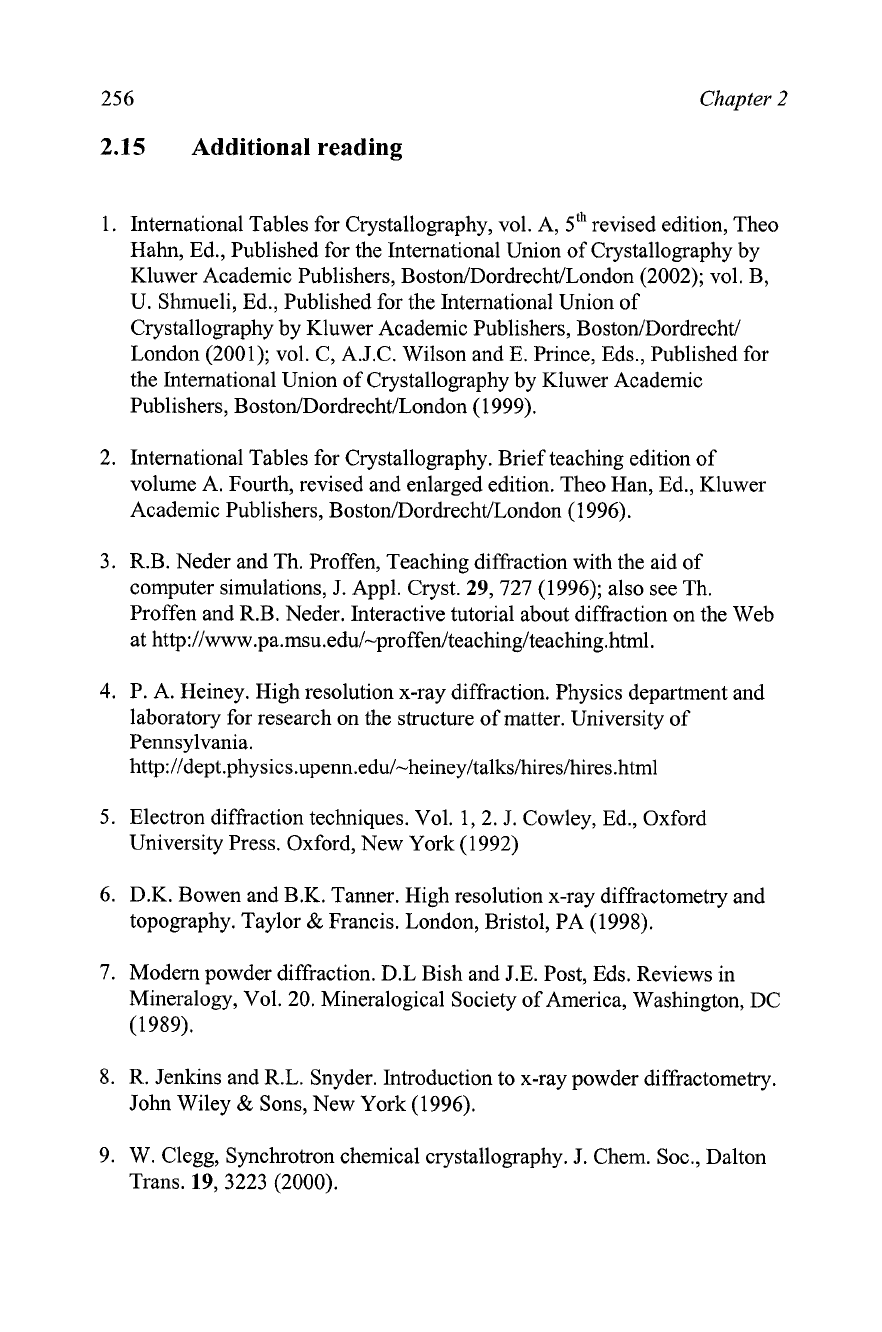
256
Chapter
2
2.15
Additional reading
1. International Tables for Crystallography, vol. A, 5th revised edition, Theo
Hahn, Ed., Published for the International Union of Crystallography by
Kluwer Academic Publishers, Boston/Dordrecht/London (2002); vol. B,
U.
Shmueli, Ed., Published for the International Union of
Crystallography by Kluwer Academic Publishers, Boston/Dordrecht/
London (2001); vol.
C,
A.J.C. Wilson and E. Prince, Eds., Published for
the International Union of Crystallography by Kluwer Academic
Publishers, BostodDordrecht/London (1999).
2. International Tables for Crystallography. Brief teaching edition of
volume A. Fourth, revised and enlarged edition. Theo Han, Ed., Kluwer
Academic Publishers, Boston/Dordrecht/London
(1
996).
3. R.B. Neder and Th. Proffen, Teaching diffraction with the aid of
computer simulations, J. Appl. Cryst. 29, 727 (1996); also see Th.
Proffen and R.B. Neder. Interactive tutorial about diffraction on the Web
at http://www.pa.msu.edu/-proffedteaching/teaching.html.
4.
P. A. Heiney. High resolution x-ray diffraction. Physics department and
laboratory for research on the structure of matter. University of
Pennsylvania.
http://dept.physics.upenn.edu/-heiney/talks/hires/hires.h~l
5. Electron diffraction techniques. Vol. 1,2. J. Cowley, Ed., Oxford
University Press. Oxford, New York (1 992)
6. D.K. Bowen and B.K. Tanner. High resolution x-ray diffractometry and
topography. Taylor
&
Francis. London, Bristol, PA (1998).
7. Modern powder diffraction. D.L Bish and J.E. Post, Eds. Reviews in
Mineralogy, Vol.
20.
Mineralogical Society of America, Washington, DC
(1989).
8. R. Jenkins and R.L. Snyder. Introduction to x-ray powder diffractometry.
John Wiley
&
Sons, New York (1996).
9. W. Clegg, Synchrotron chemical crystallography. J. Chem. Soc., Dalton
Trans. 19,3223 (2000).
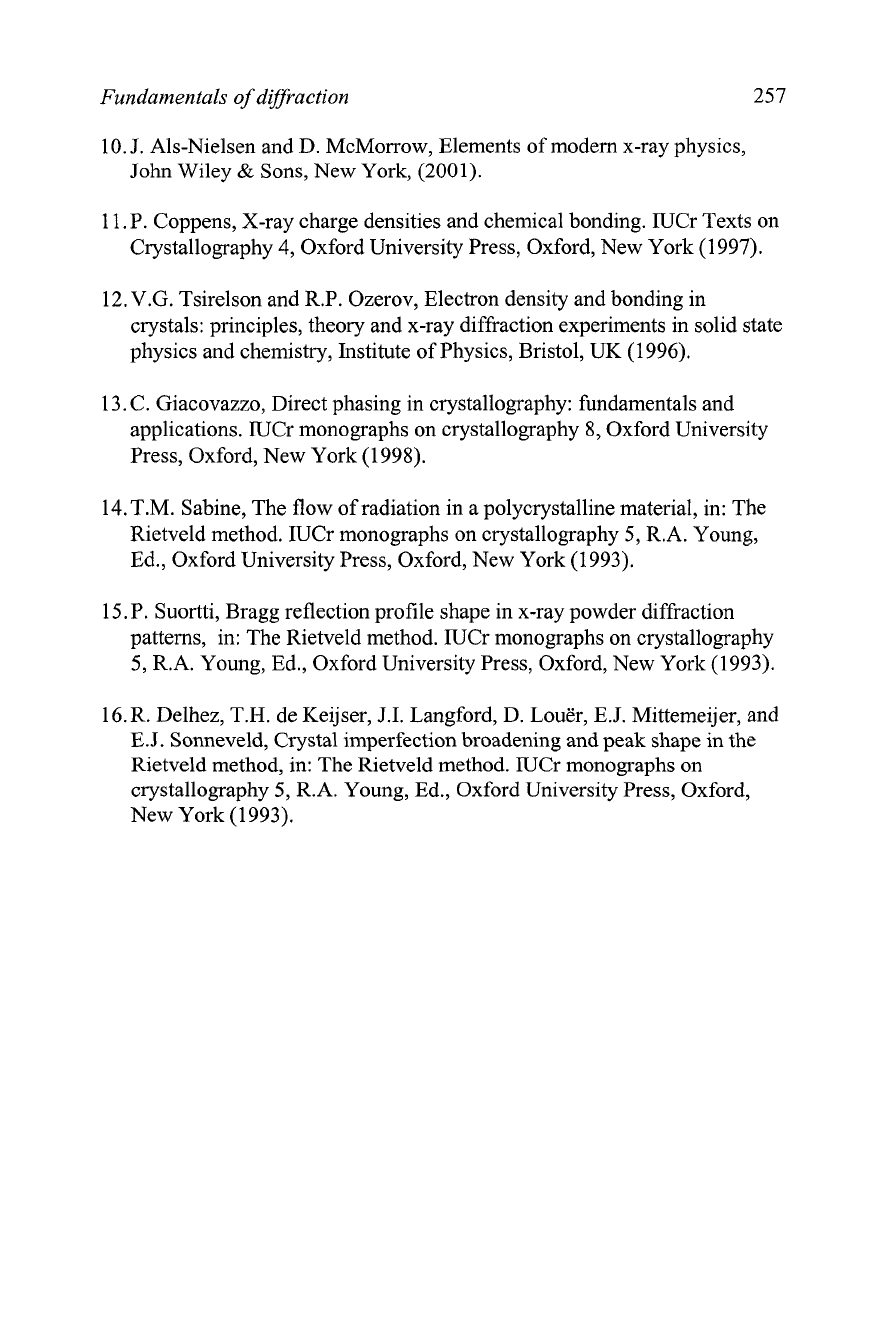
Fundamentals of diffraction
257
10.1. Als-Nielsen and D. McMorrow, Elements of modem x-ray physics,
John Wiley
&
Sons, New York, (2001).
1 1. P. Coppens, X-ray charge densities and chemical bonding. IUCr Texts on
Crystallography 4, Oxford University Press, Oxford, New York (1 997).
12. V.G. Tsirelson and R.P. Ozerov, Electron density and bonding in
crystals: principles, theory and x-ray diffraction experiments in solid state
physics and chemistry, Institute of Physics, Bristol,
UK
(1996).
13. C. Giacovazzo, Direct phasing in crystallography: fundamentals and
applications. IUCr monographs on crystallography 8, Oxford University
Press, Oxford, New York (1
998).
14. T.M. Sabine, The flow of radiation in a polycrystalline material, in: The
Rietveld method. IUCr monographs on crystallography 5, R.A. Young,
Ed., Oxford University Press, Oxford, New York (1993).
15.
P.
Suortti, Bragg reflection profile shape in x-ray powder diffraction
patterns, in: The Rietveld method. IUCr monographs on crystallography
5, R.A. Young, Ed., Oxford University Press, Oxford, New York (1993).
16.R. Delhez, T.H. de Keijser,
J.I.
Langford,
D.
Louer, E.J. Mittemeijer, and
E.J.
Sonneveld, Crystal imperfection broadening and peak shape in the
Rietveld method, in: The Rietveld method. IUCr monographs on
crystallography
5,
R.A. Young, Ed., Oxford University Press, Oxford,
New York (1993).
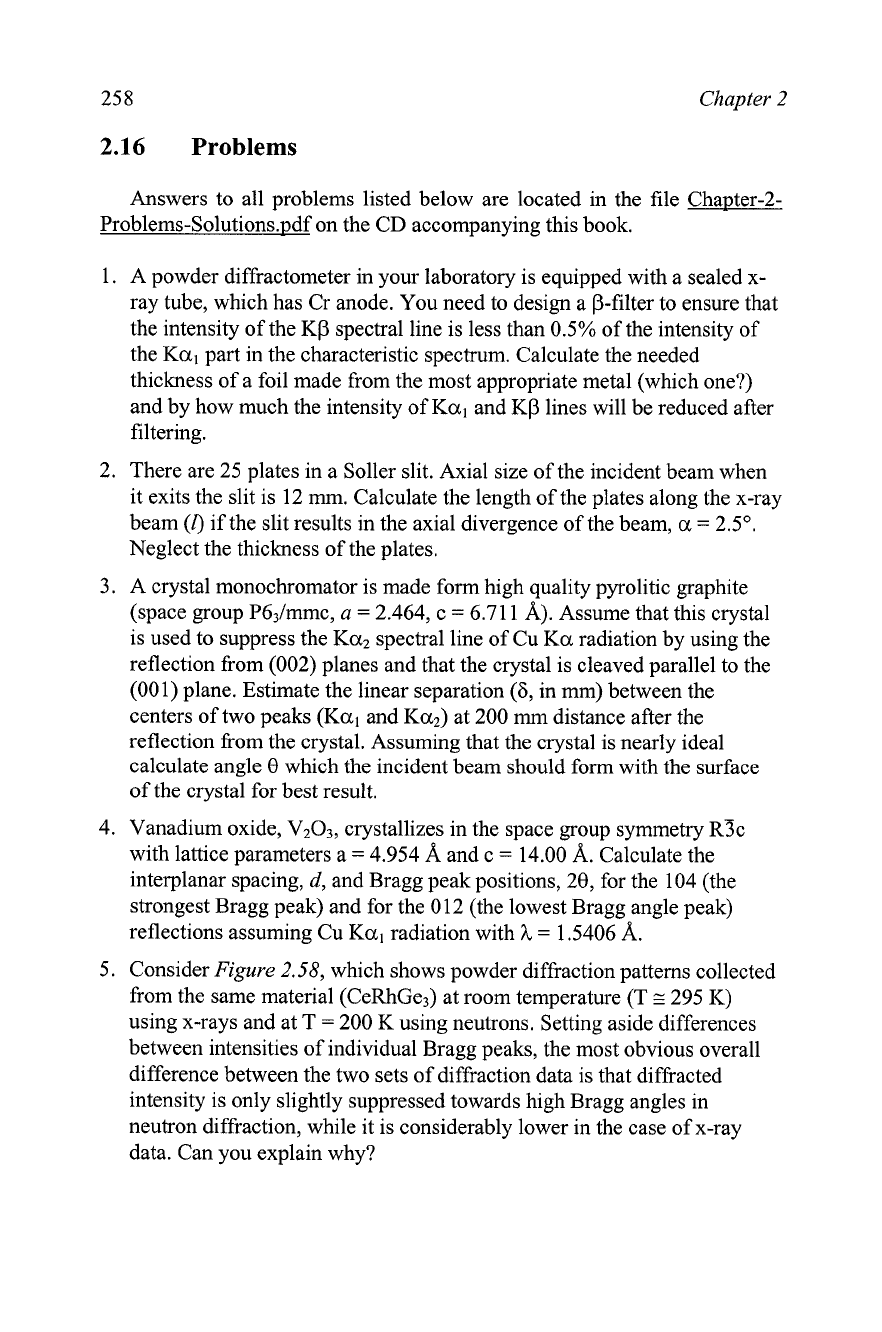
25
8
Chapter
2
2.16
Problems
Answers to all problems listed below are located in the file Chapter-2-
Problems-Solutions.pdf on the CD accompanying this book.
1. A powder diffractometer in your laboratory is equipped with a sealed x-
ray tube, which has Cr anode. You need to design a P-filter to ensure that
the intensity of the
KP spectral line is less than 0.5% of the intensity of
the Kal part in the characteristic spectrum. Calculate the needed
thickness of a foil made from the most appropriate metal (which one?)
and by how much the intensity of
Ka, and KP lines will be reduced after
filtering.
2. There are 25 plates in a Soller slit. Axial size of the incident beam when
it exits the slit is 12 mm. Calculate the length of the plates along the x-ray
beam
(I)
if the slit results in the axial divergence of the beam,
a
=
2.5".
Neglect the thickness of the plates.
3.
A crystal monochromator is made form high quality pyrolitic graphite
(space group P(i3/rnmc,
a
=
2.464, c
=
6.7 1 1
A).
Assume that this crystal
is used to suppress the Ka2 spectral line of Cu Ka radiation by using the
reflection from (002) planes and that the crystal is cleaved parallel to the
(001) plane. Estimate the linear separation
(6,
in mm) between the
centers of two peaks (Kal and Ka2) at 200
rnrn
distance after the
reflection from the crystal. Assuming that the crystal is nearly ideal
calculate angle
8
which the incident beam should form with the surface
of the crystal for best result.
4. Vanadium oxide,
V203, crystallizes in the space group symmetry R3c
with lattice parameters a
=
4.954
A
and c
=
14.00
A.
Calculate the
interplanar spacing,
d,
and Bragg peak positions,
28,
for the 104 (the
strongest Bragg peak) and for the 0 12 (the lowest Bragg angle peak)
reflections assuming Cu Kal radiation with
X
=
1.5406
A.
5. Consider
Figure
2.58,
which shows powder diffraction patterns collected
from the same material (CeRhGe3) at room temperature (T
E
295 K)
using x-rays and at T
=
200 K using neutrons. Setting aside differences
between intensities of individual Bragg peaks, the most obvious overall
difference between the two sets of diffraction data is that diffracted
intensity is only slightly suppressed towards high Bragg angles in
neutron diffraction, while it is considerably lower in the case of x-ray
data. Can you explain why?
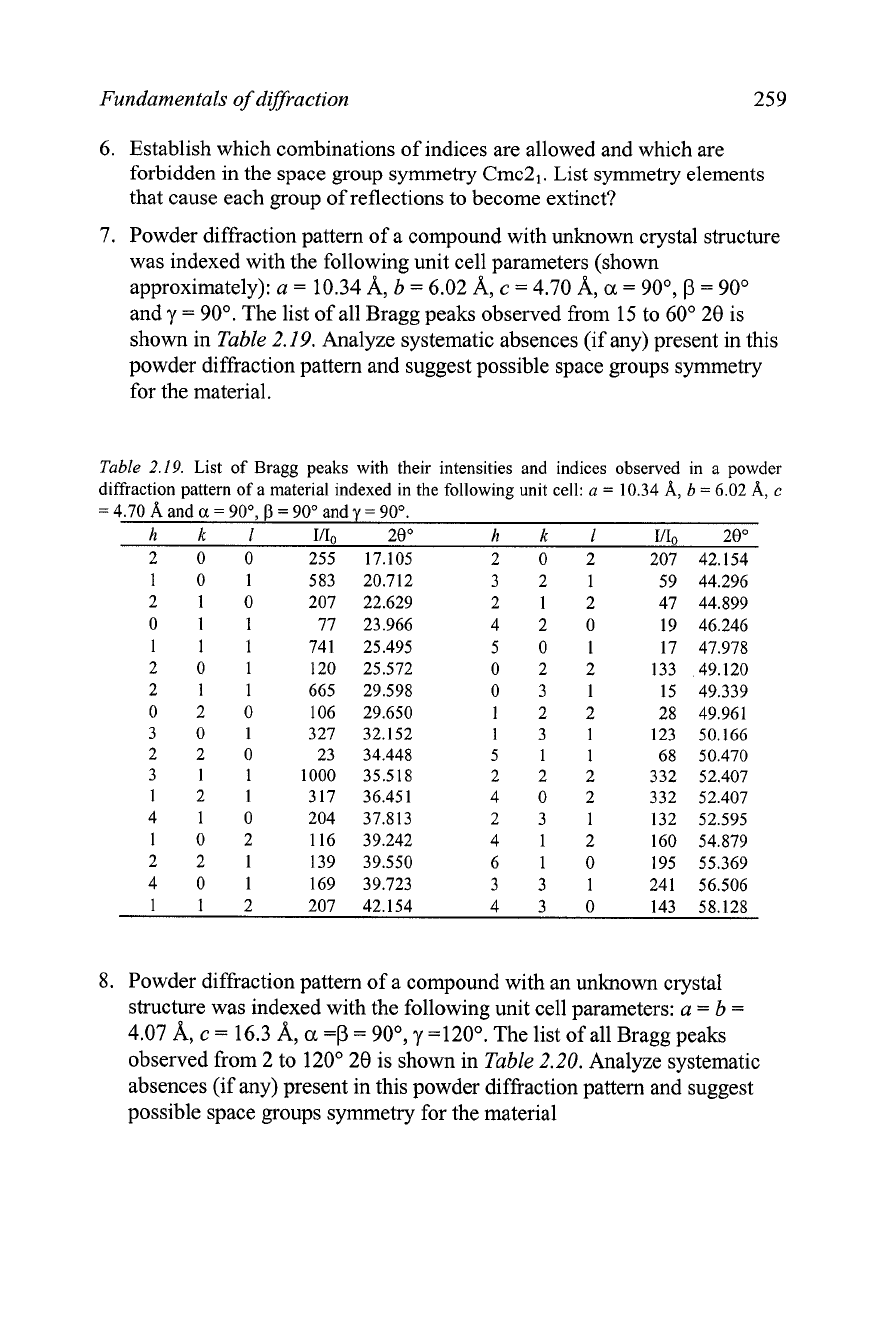
Fundamentals of diffraction
259
6. Establish which combinations of indices are allowed and which are
forbidden in the space group symmetry
Cmc2,. List symmetry elements
that cause each group of reflections to become extinct?
7. Powder diffraction pattern of a compound with unknown crystal structure
was indexed with the following unit cell parameters (shown
approximately):
a
=
10.34 A,
b
=
6.02 A,
c
=
4.70 A,
a
=
90•‹,
P
=
90"
and
y
=
90". The list of all Bragg peaks observed from 15 to 60" 28 is
shown in
Table
2.19.
Analyze systematic absences (if any) present in this
powder diffraction pattern and suggest possible space groups symmetry
for the material.
Table
2.19.
List of Bragg peaks with their intensities and indices observed
in
a powder
diffraction pattern of a material indexed in the following unit cell:
a
=
10.34
A,
b
=
6.02
A,
c
=
4.70
A
and
a
=
90•‹,
P
=
90"
and
y
=
90".
hkl
1/10 20"
hkl
1/10 20"
2 0 0 255
17.105
202 207 42.154
101 583
20.712 321
59 44.296
2
10 207
22.629
212 47 44.899
011 77
23.966
4 2 0 19 46.246
11 1 741
25.495
501 17 47.978
201
120
25.572 0 2 2
133 49.120
211
665 29.598
031 15 49.339
020
106
29.650
122 28 49.961
301 327
32.152
131 123 50.166
2 2 0
23
34.448
511 68 50.470
311 1000
35.518
2 2 2 332 52.407
121 317
36.451
4 0 2 332 52.407
4 10 204
37.813
231 132 52.595
102 116
39.242
4 12 160 54.879
221
139
39.550
610 195 55.369
401 169
39.723
331 241 56.506
112 207
42.154
430 143 58.128
8.
Powder diffraction pattern of a compound with an unknown crystal
structure was indexed with the following unit cell parameters:
a
=
b
=
4.07
A,
c
=
16.3 A,
a
=P
=
90•‹,
y
=120•‹. The list of all Bragg peaks
observed from 2 to 120" 28 is shown in
Table
2.20.
Analyze systematic
absences (if any) present in this powder diffraction pattern and suggest
possible space groups symmetry for the material
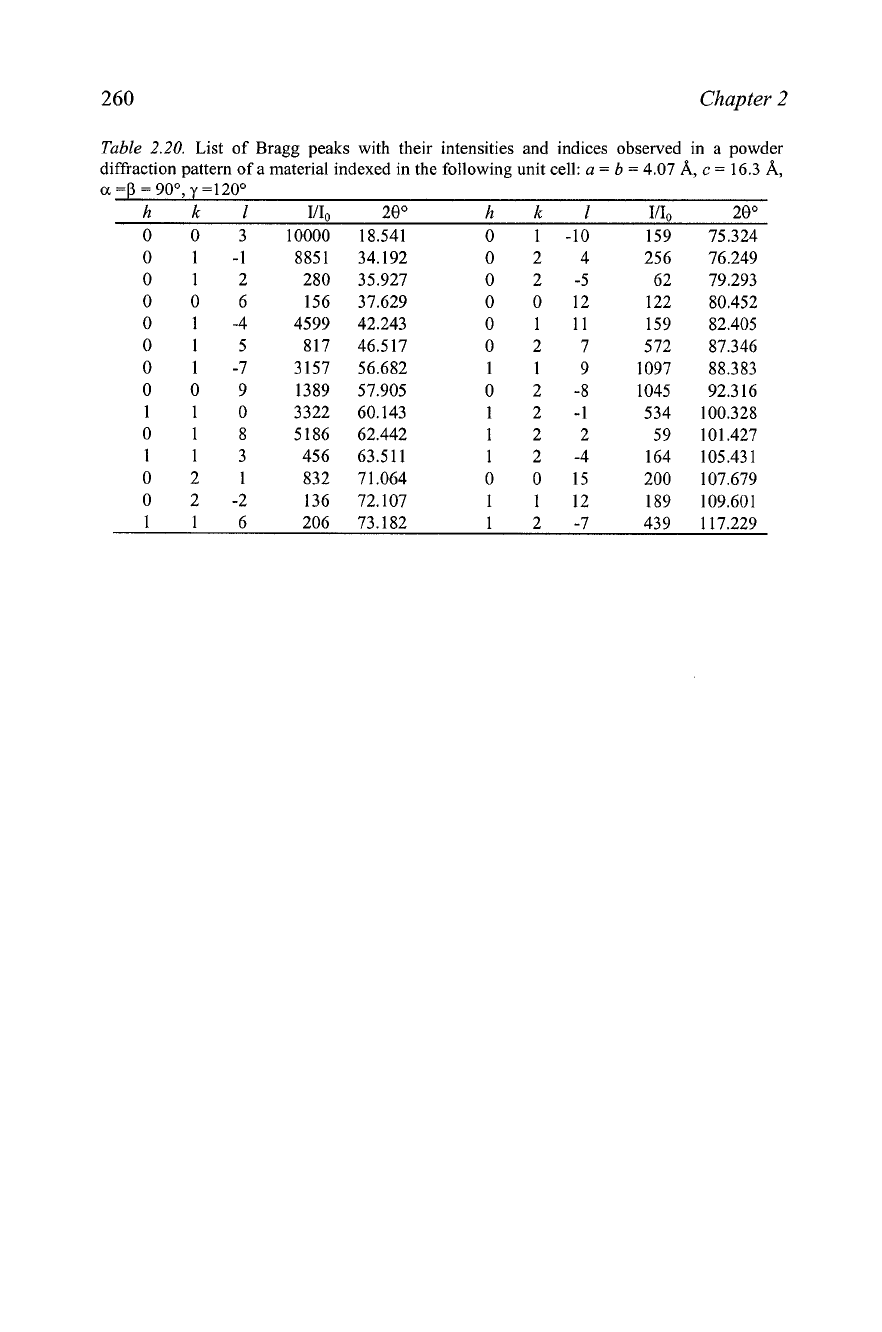
260
Chapter
2
Table
2.20.
List of Bragg peaks with their intensities and indices observed in a powder
diffraction pattern of
a
material indexed in the following unit cell:
a
=
b
=
4.07
A,
c
=
16.3
A,
a
=p
=
90•‹,
y
=120•‹
hkl
I/Io
20'
hkl
I/Io
20"
0 0 3 10000
18.541 0 1 -10 159 75.324
0 1 -1
8851
34.192 024
256 76.249
012 280
35.927 0 2 -5 62 79.293
006 156
37.629
0 0 12 122 80.452
0 1 -4 4599 42.243 0
1
11 159 82.405
015 817 46.517 0 2 7 572 87.346
0 1 -7 3157
56.682 1 1 9
1097
88.383
0 0 9 1389
57.905 0 2 -8
1045
92.316
1 1 0 3322
60.143
1 2 -1 534
100.328
0 1 8 5186
62.442
122 59
101.427
113 456 63.511 1 2 -4 164 105.431
021 832 71.064 0 0 15 200 107.679
0 2 -2 136
72.107
1 1
12 189 109.601
116
206 73.182
1 2 -7 439 117.229
